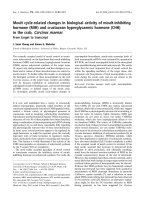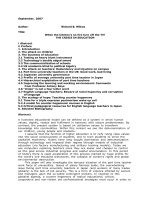Mitsopoulos pelagidis understanding the crisis in greece; from boom to bust (2011)
Bạn đang xem bản rút gọn của tài liệu. Xem và tải ngay bản đầy đủ của tài liệu tại đây (2.82 MB, 290 trang )
Copyright material from www.palgraveconnect.com - licensed to ETH Zuerich - PalgraveConnect - 2011-05-06
Understanding the Crisis in Greece
10.1057/9780230294752 - Understanding the Crisis in Greece, Michael Mitsopoulos and Theodore Pelagidis
Also by Theodore Pelagidis
Copyright material from www.palgraveconnect.com - licensed to ETH Zuerich - PalgraveConnect - 2011-05-06
WELFARE STATE AND DEMOCRACY IN CRISIS (co-edited)
10.1057/9780230294752 - Understanding the Crisis in Greece, Michael Mitsopoulos and Theodore Pelagidis
Understanding the Crisis
in Greece
Michael Mitsopoulos
and
Theodore Pelagidis
10.1057/9780230294752 - Understanding the Crisis in Greece, Michael Mitsopoulos and Theodore Pelagidis
Copyright material from www.palgraveconnect.com - licensed to ETH Zuerich - PalgraveConnect - 2011-05-06
From Boom to Bust
© Michael Mitsopoulos and Theodore Pelagidis 2011
All rights reserved. No reproduction, copy or transmission of this
publication may be made without written permission.
Any person who does any unauthorized act in relation to this publication
may be liable to criminal prosecution and civil claims for damages.
The authors have asserted their rights to be identified as the authors of this
work in accordance with the Copyright, Designs and Patents Act 1988.
First published 2011 by
PALGRAVE MACMILLAN
Palgrave Macmillan in the UK is an imprint of Macmillan Publishers Limited,
registered in England, company number 785998, of Houndmills, Basingstoke,
Hampshire RG21 6XS.
Palgrave Macmillan in the US is a division of St Martin’s Press LLC,
175 Fifth Avenue, New York, NY 10010.
Palgrave Macmillan is the global academic imprint of the above companies
and has companies and representatives throughout the world.
Palgrave® and Macmillan® are registered trademarks in the United States,
the United Kingdom, Europe and other countries.
ISBN 978–0–230–23777–3
hardback
This book is printed on paper suitable for recycling and made from fully
managed and sustained forest sources. Logging, pulping and manufacturing
processes are expected to conform to the environmental regulations of the
country of origin.
A catalogue record for this book is available from the British Library.
Library of Congress Cataloging-in-Publication Data
Mitsopoulos, Michael.
Understanding the crisis in Greece : from boom to bust / Michael
Mitsopoulos and Theodore Pelagidis.
p. cm.
ISBN 978–0–230–23777–3
1. Financial crises—Greece—History—21st century. 2. Greece—
Economic conditions—1974– 3. Political corruption—Greece—History—
21st century. I. Pelagidis, Theodore. II. Title.
HB3807.5.M58 2011
330.9495—dc22
2010034185
A catalog record for this book is available from the Library of Congress.
10 9 8 7 6 5 4 3
2 1
20 19 18 17 16 15 14 13 12 11
Printed and bound in Great Britain by
CPI Antony Rowe, Chippenham and Eastbourne
10.1057/9780230294752 - Understanding the Crisis in Greece, Michael Mitsopoulos and Theodore Pelagidis
Copyright material from www.palgraveconnect.com - licensed to ETH Zuerich - PalgraveConnect - 2011-05-06
No portion of this publication may be reproduced, copied or transmitted
save with written permission or in accordance with the provisions of the
Copyright, Designs and Patents Act 1988, or under the terms of any licence
permitting limited copying issued by the Copyright Licensing Agency,
Saffron House, 6–10 Kirby Street, London EC1N 8TS.
To Georgia and to our daughter Veronica
M. M.
Copyright material from www.palgraveconnect.com - licensed to ETH Zuerich - PalgraveConnect - 2011-05-06
To Elli
T. P.
10.1057/9780230294752 - Understanding the Crisis in Greece, Michael Mitsopoulos and Theodore Pelagidis
10.1057/9780230294752 - Understanding the Crisis in Greece, Michael Mitsopoulos and Theodore Pelagidis
Copyright material from www.palgraveconnect.com - licensed to ETH Zuerich - PalgraveConnect - 2011-05-06
This page intentionally left blank
Contents
xi
Part I
1 Introduction
3
2 Vikings in Greece: Rents, the Design of the Greek
Political System and the Blockage of Reforms
6
2.1 Introduction
6
2.2 Description of the players of the game
7
2.3 Powerful interest groups as rent-seeking “Vikings”
in Greece
8
2.4 Rationally ignorant and misinformed voters who are
afraid of reform
10
2.5 The role of the media as an obstacle to reform
14
2.6 The administration as a prize for the interest groups
15
2.7 The failure of the mandate holders
16
2.8 Conclusion
20
References
22
3 Corruption, Policy Inadequacy and the Greek
Constitution
24
3.1 Introduction
24
3.2 Literature survey
26
3.3 Mandate holders and their motive to get corrupted
30
3.4 Democracy: The strength of the government,
minorities and the separation of powers
32
3.5 Minorities: Potential corruptors and protectors
of democracy
34
3.6 The practice of creating strong governments with
sufficient separation of powers
37
3.7 Proposals for constitutional reform in Greece
48
3.8 Conclusion
51
References
52
vii
10.1057/9780230294752 - Understanding the Crisis in Greece, Michael Mitsopoulos and Theodore Pelagidis
Copyright material from www.palgraveconnect.com - licensed to ETH Zuerich - PalgraveConnect - 2011-05-06
List of Figures
viii Contents
55
4.1 Introduction
55
4.2 Measures of the judiciary’s efficiency
57
4.3
4.4
4.5
Analysis of an indirect measure of the time required
to dispose justice in Greece
59
Appeals court decisions – case facts as a direct proxy
for the time needed to dispose justice in Greece
63
European Court of Human Rights decisions regarding
delays in Greek courts
68
4.6 Time needed to dispose cases and resources
71
4.7 The increase in the appellate rate
74
4.8 The cost of using official arbitration
76
4.9
Rents and the judiciary: The Greek case of demand
and supply for legal services
4.10 Simplifying procedures and strengthening
accountability
77
84
4.11 Preserving the independence of the judiciary during
reform
102
4.12 Conclusions
103
References
104
Part II
5 Strong Growth and Weak Institutions: The Greek
Paradox Reconsidered
109
5.1 Introduction
109
5.2 Greece: Rapid growth over the past years
111
5.3 Low competitiveness combined with a weak labor
market
121
5.3.1 Low competitiveness
121
5.3.2 A weak labor market
136
5.4 Taxation and labor market paradoxes
144
5.4.1 Facts on personal income taxation
144
5.4.2 A summary of the facts on personal income
taxation
160
5.4.3 Paradoxes of the Greek labor market explained
163
10.1057/9780230294752 - Understanding the Crisis in Greece, Michael Mitsopoulos and Theodore Pelagidis
Copyright material from www.palgraveconnect.com - licensed to ETH Zuerich - PalgraveConnect - 2011-05-06
4 Efficiency and Quality of Justice in Greece
Contents ix
Appendix 1 Road Transport in Greece and Government
Intervention
A1.1 An example of how the reform debate in Greece does
not focus on issues that are crucially related to the low
competitiveness of the country
Appendix 2 Shop Opening Hours in Greece
165
165
174
182
187
198
206
214
219
227
227
231
A2.1 An example of how consumer interests are not a
consideration in reform debates when one
has to deregulate, rather than regulate
231
Appendix 3 Basic Examples of Details that Degrade the
Greek Business Environment
A3.1 Tax on raised capital
A3.1.1 The situation in Greece
A3.1.2 European trends
A3.2 Publications in the Government Gazette
A3.2.1 The situation in Greece
A3.2.2 European trends
A3.3 Multiple notifications of a new hiring
A3.3.1 The situation in Greece
A3.3.2 European trends
A3.4 Taxing the transfer of private limited companies
A3.4.1 The situation in Greece
A3.4.2 European trends
236
236
236
236
236
236
237
237
237
238
238
238
238
10.1057/9780230294752 - Understanding the Crisis in Greece, Michael Mitsopoulos and Theodore Pelagidis
Copyright material from www.palgraveconnect.com - licensed to ETH Zuerich - PalgraveConnect - 2011-05-06
5.5 Private sector salaried employment attributes, corporate
taxation and corporate profitability
5.5.1 Private sector salaried employment, employer
size and the relative attractiveness of public
sector employment
5.5.2 Corporate income tax contribution in Greece
5.5.3 Profitability of Greek companies
5.6 The current crisis and the Greek financial system
5.7 Certain basic parameters of the Greek pension system
5.8 Main parameters of the Greek public finances
5.9 The examples of Finland and Ireland and how they
can be an example for Greece
5.10 Conclusions
Contents
A3.5 Regulatory impact assessment
238
A3.5.1 The situation in Greece
238
A3.5.2 European trends
239
A3.6 Certificate of origin for exports
239
A3.6.1 The situation in Greece
239
A3.6.2 European trends
240
References for Chapter 5 and Appendices
241
Notes
246
Index
249
10.1057/9780230294752 - Understanding the Crisis in Greece, Michael Mitsopoulos and Theodore Pelagidis
Copyright material from www.palgraveconnect.com - licensed to ETH Zuerich - PalgraveConnect - 2011-05-06
x
2.1
Total income declared by income bracket
Source: Ministry of Finance data for financial year 2007
18
2.2
Total income tax paid by income bracket
Source: Ministry of Finance data for financial year 2007
18
4.1
Remaining cases and postponed cases as percentage of total
cases introduced
60
Sources: National Statistical Service of Greece (ESYE), authors’
computations
4.2
Unresolved and postponed cases to total cases introduced.
Civil courts
Source: National Statistical Service of Greece (ESYE), authors’
computations
4.3
Unresolved to total cases introduced. Administrative courts
Source: National Statistical Service of Greece (ESYE), authors’
computations
4.4
Only unresolved cases compared to unresolved and
postponed cases to total cases introduced. Civil courts
Source: National Statistical Service of Greece (ESYE), authors’
computations
4.5
4.6
61
62
Duration of cases that have been ordered to be retried by
the Areios Pagos in 2006
Source: Published court decisions for 2006
66
Duration of cases that have been reaffirmed by the
Areios Pagos in 2006
Source: Published court decisions for 2006
67
4.7
Budget of the Ministry of Justice as a percentage of the GDP
Source: Government annual budgets
4.8
New cases introduced to appeals courts to cases concluded
by first instance courts
Source: National Statistical Service of Greece (ESYE), authors’
computations
4.9
61
Composition of regulation indices constructed by
Paterson et al. (2003) for lawyers and notaries public
72
76
79
xi
10.1057/9780230294752 - Understanding the Crisis in Greece, Michael Mitsopoulos and Theodore Pelagidis
Copyright material from www.palgraveconnect.com - licensed to ETH Zuerich - PalgraveConnect - 2011-05-06
List of Figures
xii List of Figures
Overall indicator for legal services according to OECD
indicator of regulatory conditions in professional
services sectors
Source: OECD
4.11 Comparison of details of list of procedural steps
necessary to enforce a contract by Doing Business
for Greece, France and Germany
Source: www.doingbusiness.org
5.1
Real GDP growth in Greece and Europe
Source: AMECO
5.2
Timing of reforms in energy, transport and
communications (increase in reform effort)
Source: OECD International Regulation Database
Economics Dept. Working Paper no. 530, 2006
80
101
111
112
5.3
Demand injections in Greece
Sources: Bank of Greece, Ministry of Finance, European
Commission and Eurostat
113
5.4
Interbank rates
Source: Bank of Greece
114
5.5
Price index changes as a percentage, year-on-year
Sources: ESYE and Eurostat
114
5.6
Yearly percentage change in financing of households
and businesses from domestic MFIs
Sources: European Central Bank and Bank of Greece
115
Loans by MFIs as a percentage of the GDP.
November 2008 data. NF: Non-financial
Source: European Central Bank
116
Government gross consolidated debt and loans by
MFIs as a percentage of the GDP. November 2008 data.
NF: Non-financial Eurozone member countries
Sources: European Central Bank and European
Commission
116
5.7
5.8
5.9
Total indebtness as a percentage of the GDP. Greece
and eurozone average
Sources: European Central Bank, Bank of Greece and
European Commission
117
10.1057/9780230294752 - Understanding the Crisis in Greece, Michael Mitsopoulos and Theodore Pelagidis
Copyright material from www.palgraveconnect.com - licensed to ETH Zuerich - PalgraveConnect - 2011-05-06
4.10
List of Figures xiii
5.11 Investment-to-GDP ratio. Greece and eurozone
Source: Eurostat
117
118
5.12 Employment expectations in construction. Greece
and eurozone
Source: European Commission
119
5.13 Credit expansion and private consumption yearly
change. Greece
Sources: ESYE and Bank of Greece
120
5.14 Year-on-year percentage change in private consumption
and investment
Source: ESYE
120
5.15 Inflation differential. Goods and services. Greece versus
eurozone (EA-13)
Source: Eurostat
121
5.16 Inflation differential. Goods and services. Greece and
Ireland versus eurozone
Source: Eurostat
122
5.17 Goods and services balance as a percentage of the GDP.
Greece and Ireland
Source: Eurostat
123
5.18 Goods and services balance as a percentage of the GDP.
Greece
Source: Eurostat
124
5.19 Direct investment in reporting economy. FDI inward
(net flow change in billion euros)
Source: UNCTAD
125
5.20 Competitiveness ranking, corruption ranking and income
ranking. All countries
Sources: Doing Business, World Economic Forum,
Transparency International and United Nations
5.21 Administrative cost as a percentage of the GDP by
EU member state
Source: Kox (2005) as CPB’s contribution to the EU’s 2005
Competitiveness Report
128
129
10.1057/9780230294752 - Understanding the Crisis in Greece, Michael Mitsopoulos and Theodore Pelagidis
Copyright material from www.palgraveconnect.com - licensed to ETH Zuerich - PalgraveConnect - 2011-05-06
5.10 Year-on-year percentage price index changes. General
price index and index for telecommunication services
Source: ESYE
5.22 OECD regulation index for professional services
Sources: OECD indicator for regulation in professional
services, (2007)
130
5.23 Corruption and regulation, all countries
Sources: World Bank and Transparency International
131
5.24 State control – price controls
Source: OECD. Index scale of 0–6 from least to
most restrictive
132
5.25 State control. Use of command and control regulation
Source: OECD. Index scale of 0–6 from least to
most restrictive
133
5.26 Administrative burdens on start-ups
Source: OECD. Index scale of 0–6 from least to
most restrictive
134
5.27 Barriers to entrepreneurship – Sector-specific
administrative burden
Source: OECD. Index scale of 0–6 from least to
most restrictive
134
5.28 Barriers to entrepreneurship – Barriers to entry in services
Source: OECD. Index scale of 0–6 from least to
most restrictive
135
5.29 Barriers to FDI
Source: OECD. Index scale of 0–6 from least to
most restrictive
135
5.30 State control. Involvement in business operation
Source: OECD. Index scale of 0–6 from least to
most restrictive
136
5.31 Wage earnings in Greece as an average of EU-15 for
comparable household
Source: Eurostat
5.32 GDP and employment growth. Greece
Source: National Statistical Service of Greece (ESYE)
5.33 Employment, old age population and unemployment
rate in Greece
Sources: ESYE and Eurostat
5.34 Unemployment in Greece, Eurozone 16 (EA-16) and the US
Source: Eurostat
137
138
138
139
10.1057/9780230294752 - Understanding the Crisis in Greece, Michael Mitsopoulos and Theodore Pelagidis
Copyright material from www.palgraveconnect.com - licensed to ETH Zuerich - PalgraveConnect - 2011-05-06
xiv List of Figures
List of Figures xv
139
5.36 Adjusted wage share. Greece and EU-15
Source: AMECO
141
5.37 Hours of employment. Various countries
Source: OECD
142
5.38 Wage earners to self-employed (non-employers) in
European countries. Q1 2007 data
Source: Eurostat
5.39 EPL. Restrictiveness and diversion of protection
legislation on temporary employment
Source: OECD. Index scale of 0–6 from least to most
restrictive
5.40 Progressivity of income taxes (without social security
contributions)
Sources: OECD Taxing Wages Database and OECD
Calculations
5.41 Distribution of monthly wages and corresponding
tax wedge.
Source: IKA for employee distribution data, Ministry
of Finance for wedge and authors’ computations
142
143
144
145
5.42 Personal income tax brackets. European countries
Source: European Commission and Ministry of Finance
149
5.43 Minimum wages. European countries
Source: Eurostat
150
5.44 Proportion of full-time workers earning minimum wage
Source: Eurostat
150
5.45 Employment rate and tax wedge in Greece
Source: OECD
151
5.46 Average income to median income. Percentage difference.
European countries
Source: Eurostat for year 2006
5.47 S80/S20 income quintile share ratio. European countries
Source: Eurostat for year 2006
151
152
10.1057/9780230294752 - Understanding the Crisis in Greece, Michael Mitsopoulos and Theodore Pelagidis
Copyright material from www.palgraveconnect.com - licensed to ETH Zuerich - PalgraveConnect - 2011-05-06
5.35 Employment ratio for the population over 15 years of
age for various European countries
Source: OECD
5.48 Income from salaries and wages, and self-employment to
total income per bracket. Greece for financial year 2007
Source: Ministry of Finance
153
5.49 Taxable income and personal income tax per income
bracket. Greece for financial year 2007
Source: Ministry of Finance
153
5.50 Greek workforce by insurance type
Source: ESYE labor force survey for Q4 2008. Insured
by IKA may include up to 200,000 that work for
publicly-owned companies or entities controlled by
the general and central government
5.51 Personal income declared and tax paid per income
bracket. Greece for financial year 2007
Sources: Data of the annual statistical bulletin of Tax Data,
General Secretariat for Information Systems, Ministry of
Finance
5.52 Percentage of individuals according to declared income
per income bracket in financial year 2007
Source: Ministry of Finance
5.53 Taxation trends in the EU. Tax contributions by Source as
a percentage of the GDP
Source: Taxation trends in the EU, 2008 edition, European
Commission
5.54 Product market regulation and total economy labor
productivity acceleration in OECD countries
Source: Graph from Conway et al. (2006), “Regulation,
Competition and Productivity Convergence.” OECD
Economics dept. Working Paper no. 509
154
155
156
159
164
5.55 Real unit labor cost in Greece relatively to rest of EU-15
Source: AMECO.
164
5.56 Labor productivity. European countries
Source: European Economic Forecasts Autumn 2009,
European Commission
167
5.57 Real compensation per employee. European countries
Source: European Economic Forecasts Autumn 2006,
European Commission
169
10.1057/9780230294752 - Understanding the Crisis in Greece, Michael Mitsopoulos and Theodore Pelagidis
Copyright material from www.palgraveconnect.com - licensed to ETH Zuerich - PalgraveConnect - 2011-05-06
xvi List of Figures
List of Figures xvii
5.59 Employers and total social security contributions by
employer size. Greece
Source: IKA data from June 2008. Employer size is by
number of employees insured with IKA
5.60 Employers and insured employees. By employer size.
Greece
Source: IKA data from June 2008. Employer size is by
number of employees insured with IKA
5.61 Full-time and part time employment according to
employer size. Greece
Source: IKA data from June 2008. Employer size is by
number of employees insured with IKA
170
171
171
172
5.62 Monthly gross salary for private and public control.
European countries
Source: Eurostat
173
5.63 Taxation trends in the EU. Direct taxes, corporate
taxes as a percentage of the GDP
Source: European Commission
176
5.64 Dividend taxation, upon distribution to individuals,
and taxation of corporate income. European countries
Source: Tax database, European Commission
177
5.65 Corporate and personal income tax as a percentage
of the GDP. Greece and EU-13, data for year 2005
Source: European Commission
178
5.66 Profits and tax according to legal form of enterprises. Greece
Source: Ministry of Finance, General Secretariat for
Information Systems
181
5.67 Official and effective tax rates per fiscal year. Greece
Source: Ministry of Finance, General Secretariat for
Information Systems
183
5.68 Profitability of Greek manufacturing
Source: ICAP
185
5.69 Profitability of non-financial companies. European countries
Sources: BACH database and ICAP
186
10.1057/9780230294752 - Understanding the Crisis in Greece, Michael Mitsopoulos and Theodore Pelagidis
Copyright material from www.palgraveconnect.com - licensed to ETH Zuerich - PalgraveConnect - 2011-05-06
5.58 Average monthly remuneration, full-time and part-time
employment. By employer size. Greece. In euros
Source: IKA data from June 2008. Employer size is by
number of employees insured with IKA
xviii List of Figures
188
5.71 Government debt and balance of payment as a
percentage of the GDP. European countries
Source: Eurostat
188
5.72 Sovereign debt ratings. January 2009. Eurozone
member countries
Source: Rating agencies
189
5.73 Tier 1 according to ECB. Eurozone member
countries banking sector. End of 2008
Source: European Central Bank (ECB)
194
5.74 Profitability of banking sector in OECD countries
Source: OECD Banking profitability data
196
5.75 Expenditure of eurozone member countries’ banking
sector as a percentage of the total assets in 2008
Source: European Central Bank (ECB)
197
5.76 Total operating income of eurozone member countries’
banking sector as a percentage of the total assets in 2008
Source: European Central Bank (ECB)
197
5.77 Total profits before tax of eurozone member countries’
banking sector as a percentage of the total assets in 2008
Source: European Central Bank (ECB)
197
5.78 Number of Greek pensioners
Sources: Ministry of Employment and Social Protection,
General Secretariat for Social Security. Social budget
of 2007. Government budget, various years. Data for
calendar year 2007 and 2001, as specified
199
5.79 Greek yearly expenditure on pensions
Sources: Government budget, social budget and Fund
of Political Employees of Public Sector
200
5.80 Average monthly expenditure per Greek pensioner
Sources: As in figures 5.78 and 5.79
200
5.81 Distribution of Greek main and supplementary
pensions in 2005
Source: The pensions for 2005 are given by the
Panhellenic Federation of Employees of Institutions
of Social Policy. The Ministry of Employment and Social
Protection does not supervise the sea worker’s fund (NAT)
and the main pension plan for government employees
202
10.1057/9780230294752 - Understanding the Crisis in Greece, Michael Mitsopoulos and Theodore Pelagidis
Copyright material from www.palgraveconnect.com - licensed to ETH Zuerich - PalgraveConnect - 2011-05-06
5.70 Greek and German ten-year government bond yields
Sources: Bank of Greece and Bundesbank
List of Figures xix
5.83 Distribution of retiriement age for IKA, men and
women in 2005
Source: Annual report of IKA for 2006
5.84 Average retirement age for IKA. Old age and inability
Source: Annual reports of IKA
203
203
204
5.85 Average full work years retirement at IKA. Old age
and inability
Source: Annual reports of IKA
204
5.86 Net revenue, primary expenditure and interest
expenditure of Greek central government budget
Source: Annual government budgets
207
5.87 Interest cover of Greek general government
Source: Annual government budgets
5.88 Interest payments to government debt and ten-year
government bond yields. Greece
Sources: Annual government budgets and Bank of Greece
209
209
5.89 General government expenditure as a percentage of
the GDP. Greek Stability and Growth Program
projections. January 2010
211
5.90 General government expenditure reduction and revenue
increase as a percentage of the GDP. Greek Stability and
Growth Program projections. January 2010
212
5.91 Extraordinary measures taken by the Greek government
for the stabilization of the fiscal situation until April 2010
Source: Government announcements and government
pursers’ estimates that accompanied draft laws
213
10.1057/9780230294752 - Understanding the Crisis in Greece, Michael Mitsopoulos and Theodore Pelagidis
Copyright material from www.palgraveconnect.com - licensed to ETH Zuerich - PalgraveConnect - 2011-05-06
5.82 Distribution of Greek main pensions except farmers
fund and comparison with farmers fund in 2005
Source: The pensions of 2005 are given by the Panhellenic
Federation of Employees of Institutions of Social Policy.
The Ministry of Employment and Social Protection does
not supervise the sea worker’s fund (NAT) and the main
pension plan for government employees
10.1057/9780230294752 - Understanding the Crisis in Greece, Michael Mitsopoulos and Theodore Pelagidis
Copyright material from www.palgraveconnect.com - licensed to ETH Zuerich - PalgraveConnect - 2011-05-06
This page intentionally left blank
Copyright material from www.palgraveconnect.com - licensed to ETH Zuerich - PalgraveConnect - 2011-05-06
Part I
10.1057/9780230294752 - Understanding the Crisis in Greece, Michael Mitsopoulos and Theodore Pelagidis
10.1057/9780230294752 - Understanding the Crisis in Greece, Michael Mitsopoulos and Theodore Pelagidis
Copyright material from www.palgraveconnect.com - licensed to ETH Zuerich - PalgraveConnect - 2011-05-06
This page intentionally left blank
1
In December 2008, downtown Athens experienced three nights of street
battles, arson and looting that became headlines in the international
press. The pictures of these riots brought suddenly into the spotlight
the reality of a Greece that struggles and seems increasingly deprived of
any positive prospects in the aftermath of the recent financial crisis, at a
time that the global economy seems to gradually recover. This picture is
in sharp contrast to the constant and high growth rates of a Greece that
managed to join the eurozone a decade earlier. But a closer inspection
of the fast growing Greek economy in the past 15 years and the failing
economy that teeters on the edge of bankruptcy and freefall today reveals
that what initially appears as a unique international paradox is, in the
end – and once all the details have been carefully put together – simply a
rather straightforward textbook case of modern economics and political
economy. That is because Greece combined until now strong economic
performance – that is, rapid GDP growth and strong productivity growth –
with a very poor performance and pathologies on many other fronts.
These failings range from a massive public debt, poor labor/product
market institutions and low competitiveness to poor environmental protection, underperforming educational system and high levels of corruption. It is all these weaknesses that, when the global credit party ended,
led Greece very close to technical default and to bankruptcy.
In this context the aggregate behavior of the macroeconomy and
the individual behavior of the separate agents that form the aggregate
macroeconomy can be explained by existing theories. At the same time,
benchmarking exercises that compare data from Greece with data from
other countries are delineating a setting that can reconcile all the stylized facts that initially may have appeared as deviations from the predictions of the standard tools of economic and political analysis.
3
10.1057/9780230294752 - Understanding the Crisis in Greece, Michael Mitsopoulos and Theodore Pelagidis
Copyright material from www.palgraveconnect.com - licensed to ETH Zuerich - PalgraveConnect - 2011-05-06
Introduction
Understanding the Crisis in Greece
We show in parallel how the case of Greece is unique: the factors
that have contributed to the strong economic performance of the past
years have made the extraction of rents even more lucrative in this
documented environment of weak institutions and weak governance.
Thanks to the factors that had contributed to strong growth, the weakened institutions and the predatory behavior of aggressive rent-seeking
groups have not led to the expected decline of the prosperity of the
economy. Such decline could have reduced the ability of these groups
to reward those that support them and to actively promote their goals
with the help of plentiful resources.
The facts presented furthermore dispel any hopes that the country will
automatically revert to the strong growth rates of the past. They also reveal
that only a determined reform effort to address the weaknesses and failings that persisted all these years will successfully solve both the urgent
problems faced currently by the economy (in particular, the public sector finances) and the significant challenges faced by a severely damaged
society that must also deal with the rapidly deteriorating prospects of an
already weak job market in an uncompetitive economy. By describing
the details of this reality we are also able to present an overview of the
problems that reform-minded politicians encounter in Greece today. As
a result we can lay out the facts that can help determined politicians to
formulate realistic and well-targeted reform strategies.
Crucially, we aim to provide a political economy explanation of how
numerous “redistributive interest groups” use the weakness as well as
the “closeness” of the Greek institutions in order to increase their rents.
In particular, in Chapter 2 we argue that the numerous rent-seeking
groups curtail competition in the product and services markets, increase
red tape and administrative burdens and actively seek to establish opacity in all administrative and legal processes. We also argue that they
do so in order to form an environment in which they will be able to
increase the rents they extract. At the same time we demonstrate how
these groups actively seek to ensure that the “rule of law” fails to such
an extent that the society will not be able to hold them accountable for
their actions. In Chapter 3 we document salient aspects of the Greek
political system that – when compared with similar aspects of the political systems of other countries – strongly point to the reason for Greek
politicians’ inability to champion reforms and effectively confront the
designs of these predatory interest groups. This analysis also shows how
the broad design of the political system is related to the perpetuation of
the current status quo. This status quo includes the failing of the “rule
of law” and the Greek judiciary as described in Chapter 4 in a context of
10.1057/9780230294752 - Understanding the Crisis in Greece, Michael Mitsopoulos and Theodore Pelagidis
Copyright material from www.palgraveconnect.com - licensed to ETH Zuerich - PalgraveConnect - 2011-05-06
4









